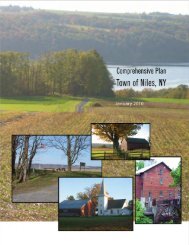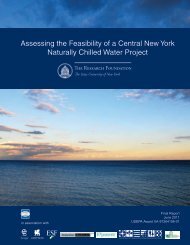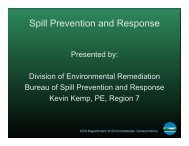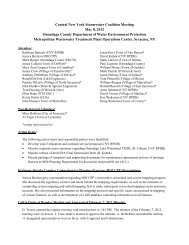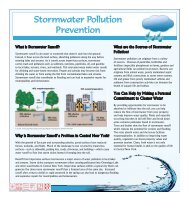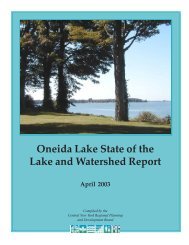A Management Strategy for Oneida Lake and its ... - CNY RPDB Home
A Management Strategy for Oneida Lake and its ... - CNY RPDB Home
A Management Strategy for Oneida Lake and its ... - CNY RPDB Home
Create successful ePaper yourself
Turn your PDF publications into a flip-book with our unique Google optimized e-Paper software.
Human Influences<br />
L<strong>and</strong> Use<br />
The <strong>Oneida</strong> <strong>Lake</strong> watershed covers 872,722<br />
acres (about 1,363 square miles) of l<strong>and</strong> area<br />
in Lewis, Madison, <strong>Oneida</strong>, Onondaga,<br />
Oswego, <strong>and</strong> Cortl<strong>and</strong> counties (Figure 3).<br />
Approximately 15,000 acres (23 square<br />
miles) of l<strong>and</strong> in the watershed within<br />
Madison <strong>and</strong> <strong>Oneida</strong> counties is owned by<br />
the <strong>Oneida</strong> Indian Nation <strong>and</strong> is primarily<br />
used <strong>for</strong> commercial <strong>and</strong> residential purposes<br />
as well as open space.<br />
According to 2002 data from the NYS<br />
Office of Real Property Services, there are<br />
approximately 120,225 parcels (a plot or<br />
tract of l<strong>and</strong>) in the watershed that vary<br />
greatly in size. The more populated cities<br />
<strong>and</strong> villages typically have a greater number<br />
of parcels that are smaller in size, while<br />
parcels in the more rural areas of the watershed<br />
tend to be much larger in size <strong>and</strong><br />
consequently fewer in number.<br />
Agricultural activity is concentrated in the<br />
southern portion of the watershed, especially<br />
Madison County <strong>and</strong> the southern portions<br />
of <strong>Oneida</strong> <strong>and</strong> Onondaga counties. Commercial<br />
<strong>and</strong> industrial activities <strong>and</strong> residential<br />
l<strong>and</strong> uses are primarily centered in <strong>and</strong><br />
around the cities <strong>and</strong> villages. There is a<br />
predominance of wild, <strong>for</strong>ested, conservation<br />
l<strong>and</strong>s, public parks, public <strong>and</strong> community<br />
service, <strong>and</strong> recreation <strong>and</strong> entertainment<br />
property in the Tug Hill Upl<strong>and</strong> region<br />
(Lewis County <strong>and</strong> northern <strong>Oneida</strong> <strong>and</strong><br />
Oswego counties), though isolated occurrences<br />
of this property can also be found<br />
throughout the watershed. Figure 4 shows<br />
the breakdown of l<strong>and</strong> use <strong>for</strong> the watershed.<br />
Agricultural L<strong>and</strong> Use<br />
Much of the <strong>Oneida</strong> <strong>Lake</strong> watershed is characterized<br />
by productive soils, favorable climate,<br />
<strong>and</strong> good market outlets <strong>for</strong> agricultural products.<br />
Over 300 commercial, full-time farms<br />
currently operate almost one-third of the l<strong>and</strong><br />
within the watershed (Table 2). No operating<br />
farms are currently known to exist in the watershed<br />
portion of Cortl<strong>and</strong> <strong>and</strong> Lewis counties.<br />
The majority of the farms are dairies located<br />
within Madison, <strong>Oneida</strong>, <strong>and</strong> Onondaga counties.<br />
These dairies have an average herd size of<br />
159 cows <strong>and</strong> grow a crop rotation of corn <strong>and</strong><br />
hay used <strong>for</strong> livestock feed. Non-dairy operations<br />
within the watershed include a thriving<br />
vegetable trade as well as burgeoning sheep,<br />
beef, <strong>and</strong> equine industries.<br />
According to data from the NYS Office of Real<br />
Property Services, approximately 29 percent of<br />
the total l<strong>and</strong> area in the <strong>Oneida</strong> <strong>Lake</strong> watershed<br />
is classified as agricultural <strong>and</strong> is primarily<br />
located in Madison, <strong>Oneida</strong>, <strong>and</strong> Onondaga<br />
counties (Table 3). Agriculture’s economic<br />
impact in the <strong>Oneida</strong> <strong>Lake</strong> watershed is at least<br />
$126 million (data is not yet available <strong>for</strong> all<br />
Onondaga<br />
15%<br />
Oswego<br />
17%<br />
L<strong>and</strong> Area<br />
Cortl<strong>and</strong><br />



